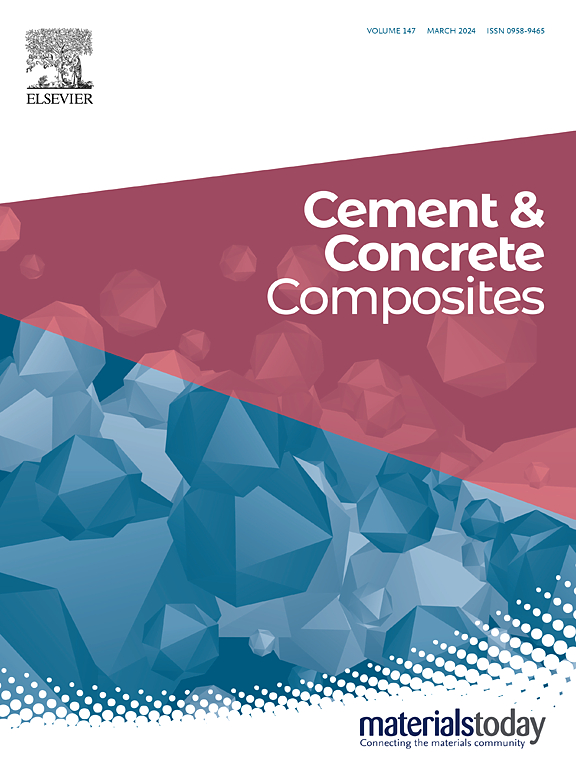定向镀镍碳纤维碱活化导电砂浆自传感性能优化
IF 13.1
1区 工程技术
Q1 CONSTRUCTION & BUILDING TECHNOLOGY
引用次数: 0
摘要
自感知混凝土(SC)是集结构和感知功能于一体的复合材料,在智能混凝土基础设施的发展中起着关键作用。采用碱活化材料(AAM)作为粘结剂,镀镍碳纤维(nfc)作为导电填料,提高碱活化导电砂浆(AACMs)的自传感性能。研究了纤维取向(随机、平行、垂直)和NCF含量(0-0.3%)对aacm电导率和压阻性能的影响。利用扫描电镜和光学显微镜对纤维-粘结剂界面和纤维取向因子进行了分析。结果表明,用nfc代替碳纤维显著降低了AACM的电阻率,而AACM在纤维取向后呈现出各向异性的电性能。平行取向的AACM在循环加载下具有低电阻率(97.97 Ω·cm)和优异的压阻性能,峰值FCR为26.1%,GF为394.05,具有良好的信号可逆性、可重复性和稳定性,而垂直取向的AACM则有不利影响。在光纤对准的帮助下,NCF含量较低(0.1 vol.%)的AACM大大提高了压阻性能。取向因子、电导率和压阻性能之间呈线性相关,证实了光纤取向对优化AACM自传感性能的作用。本文章由计算机程序翻译,如有差异,请以英文原文为准。
Optimizing the self-sensing properties of alkali-activated conductive mortar with aligned nickel-coated carbon fibers
Self-sensing concrete (SC), a composite material integrating structural and sensing functions, plays a key role in the development of intelligent concrete infrastructure. This study presents an innovative method using alkali-activated materials (AAM) as binders and nickel-coated carbon fibers (NCFs) as conductive fillers to improve the self-sensing properties of alkali-activated conductive mortars (AACMs). The influences of fiber orientation (random, parallel, vertical) and NCF content (0–0.3 %) on the electrical conductivity and piezoresistive properties of AACMs were investigated. Scanning electron microscopy (SEM) and optical microscopy were used to analyze the fiber-binder interface and fiber orientation factor. The results indicated that replacing carbon fibers with NCFs significantly reduced the resistivity of AACM, while AACM exhibited anisotropic electrical properties after fiber orientation. Parallel-oriented AACM exhibited low resistivity (97.97 Ω cm) and superior piezoresistive performance under cyclic loading, achieving a peak FCR of 26.1 % and GF of 394.05, demonstrating excellent signal reversibility, repeatability, and stability, while vertical orientation had an adverse effect. With the assistance of fiber alignment, AACM with a small NCF content (0.1 vol%) greatly enhanced the piezoresistive performance. A linear correlation was found between the orientation factor, conductivity, and piezoresistive properties, confirming the role of fiber alignment in optimizing the self-sensing performance of AACM.
求助全文
通过发布文献求助,成功后即可免费获取论文全文。
去求助
来源期刊

Cement & concrete composites
工程技术-材料科学:复合
CiteScore
18.70
自引率
11.40%
发文量
459
审稿时长
65 days
期刊介绍:
Cement & concrete composites focuses on advancements in cement-concrete composite technology and the production, use, and performance of cement-based construction materials. It covers a wide range of materials, including fiber-reinforced composites, polymer composites, ferrocement, and those incorporating special aggregates or waste materials. Major themes include microstructure, material properties, testing, durability, mechanics, modeling, design, fabrication, and practical applications. The journal welcomes papers on structural behavior, field studies, repair and maintenance, serviceability, and sustainability. It aims to enhance understanding, provide a platform for unconventional materials, promote low-cost energy-saving materials, and bridge the gap between materials science, engineering, and construction. Special issues on emerging topics are also published to encourage collaboration between materials scientists, engineers, designers, and fabricators.
 求助内容:
求助内容: 应助结果提醒方式:
应助结果提醒方式:


